By Philip Cauchi
Aim: Progress the attack.
Team function: In Possession.
Key concepts:
1. Off-the-ball movement to open passing lanes.
2. Create passing angles.
3. Attract defenders to create space.
4. Staggered lines.
5. Control with the back foot.
6. Do not turn into pressure.
Practice 1: Receive and play forward on the half turn.
Training load: Three continuous minutes followed by four minutes of mobility and dynamic stretching exercises.
Total duration: 7 minutes.
Preparation: Players are positioned in a line as follows. Player A has the ball and is positioned ten yards in front of player B. Player C is positioned ten yards behind player B. The total number of players in this setup should not be more than eight. Extra balls should be at hand in case of any mis-kicks so to keep the flow of the practice high.
Description: Player B opens up to receive the pass from player A. Player B returns the ball in the space in front of player A for the latter to play forward to player C. Prior to receiving the ball from player A, player C opens up to either to his right or to his left depending to which side player B opens up and where the return pass to player A is played. Player C dribbles the ball to player A’s original position. The players move one position forward.
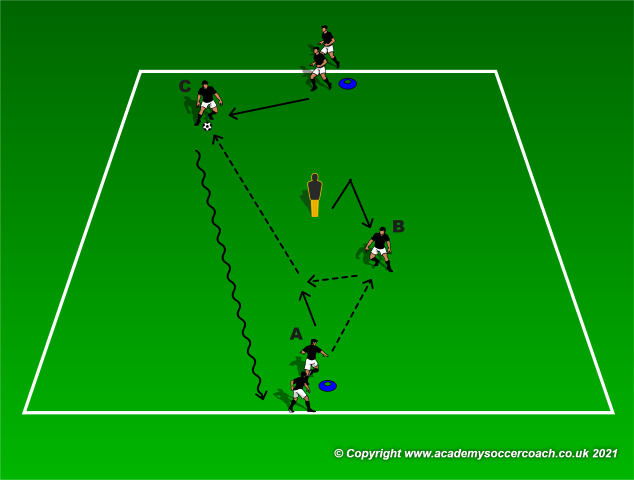
Progression:
Training load: Three continuous minutes followed by four minutes of general coordination exercises.
Total duration: 7 minutes.
Preparation: The setup is the same as in the previous practice. However, now a mini goals is added on the end line to either side of player A.
Description: Player C gets open to receive the pass from player A. At the same time player B moves to create support to player C as shown in the below image. Players B and C play 2v1 to score on the mini goal (the one on the side to where the ball was played) against player A. They have fifteen seconds available to score. Once the action is over the players move one position forward.
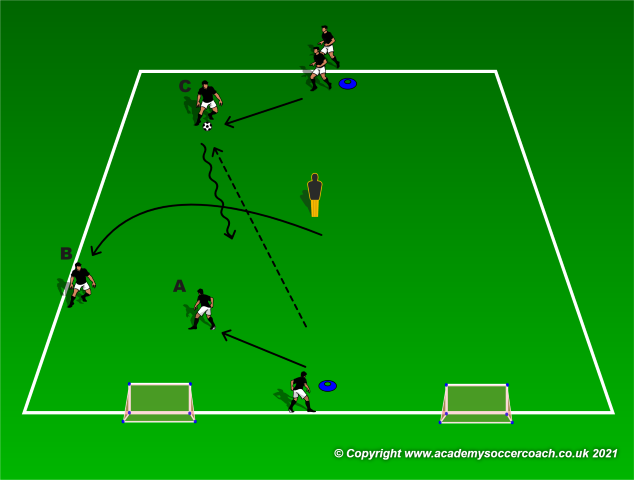
Practice 2: Play to the target player.
Training load: Six series of two minutes each and which are interspersed by a one minute rest.
Total duration: 18 minutes.
Preparation: The area of practice should measure approximately twelve yards by six yards and which is further divided into two equal zones. In each zone we have one attacker, one defender and one neutral player. The neutral players are only allowed to move along their respective end line. One of the attackers starts with the ball.
Description: The aim of this practice is for the team in attack to play the ball to a target player to score a point. If a target player has been reached, the team in possession aims to play the ball to the opposite target player. Should the defenders win the ball, roles will then be reversed. All the players are restricted to remain inside their assigned zones.
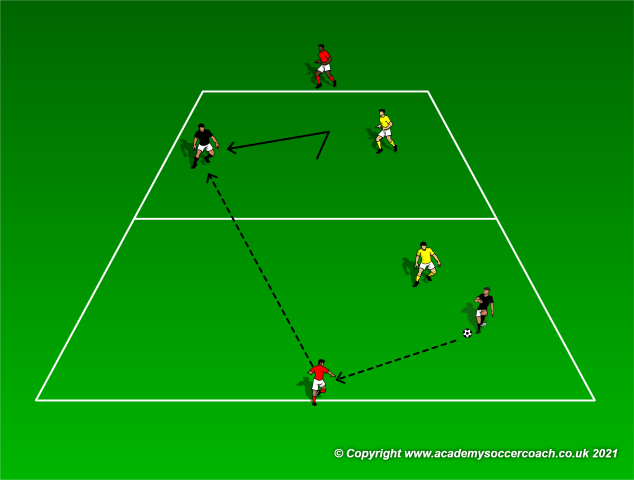
Practice 3: Positional Game 1 – Four goal game with grids.
Training load: Three series of four minutes each and which are interspersed by a one minute rest.
Total duration: 15 minutes.
Preparation: The area of practice should measure approximately twenty yards in length by twelve yards in width. The length is further divided into three zones with the outer zones measuring nine yards while the inner zone measures twelve yards. The neutral players are positioned at each side of the pitch. In the outer zones the black team and the yellow team have a player each. In the inner zone both teams have two players each. Two goals are positioned two yards away from each end line.
Description: Each team (blacks and yellow) have an assigned side to attack the two goals positioned on it while protecting their two. The players are restricted to remain inside their assigned zones. The neutral players can be allowed to score or not, depending on the level of the players.
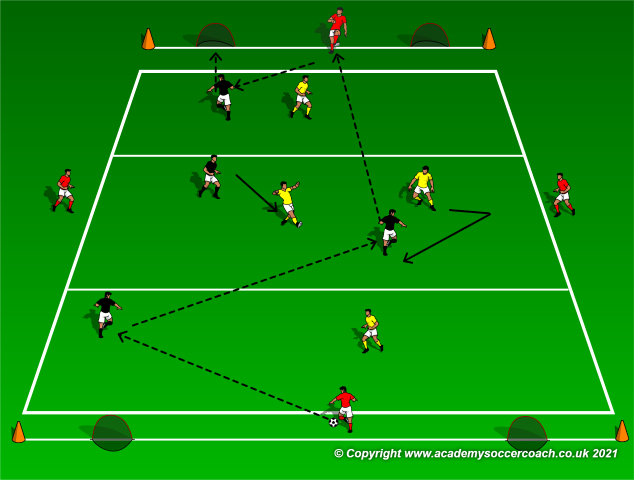
Practice 4: Positional Game 2 – Four goal game with grids.
Training load: Four series of three minutes each and which are interspersed by a one minute rest.
Total duration: 15 minutes.
Preparation: The same area with the same dimensions from the previous practice is retained. In this practice we are however focusing on attacking in scenarios within the same context. The black team attacks using width while the yellow team attacks by having numerical and positional superiorities in the inside channel. The black team have one player inside the first zone, a player in the middle zone and two players in the third zone. Two other players are allowed to move up and down the flanks. The yellow team have two players inside each zone.
Description: The black team starts play with the aim of playing through the zones to progress the attack and score from the final zone. If a goal is scored the yellow team regains possession and aim to score in the opposite direction from inside their final zone. All the players must remain in their assigned zones while the black team’s flank players not allowed to defend. Both teams should experience attacking in both ways.
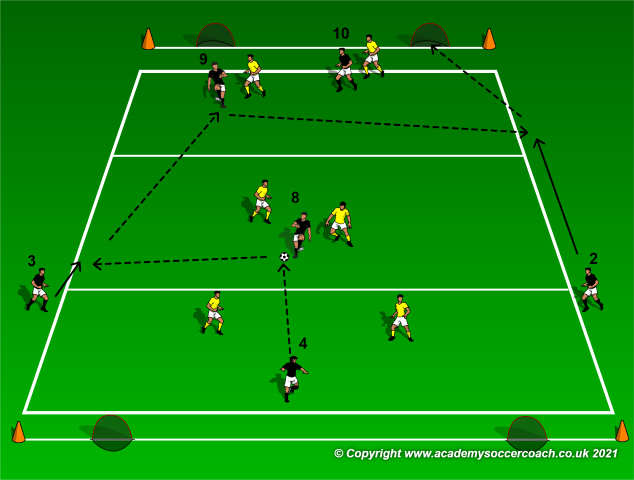
Progression:
If this game proves to be too easy for our players we should play it in the following way. The attacking team has two players wide while the defending team has two players in each zone. The game becomes more realistic and more relevant to the development of our players. In moments of transitions the team that is attacking should immediately get into a defensive formation while the team that won the ball should get wide by moving a player on each flank.
Game: 6v6 four goal game.
Training load: Three series of five minutes each and which are interspersed by a two minutes rest.
Total duration: 21 minutes.
Preparation: The area should measure forty five yards in length by thirty five yards in width. Two mini goals are positioned two yards behind each end line. The two mini goals should be positioned approximately fifteen yards apart.
Description: Two teams play without goalkeepers and in the formation as decided by the coach. No corner kicks take place. In this case restarts take place from the goal line of the team in possession of the ball. Throw-ins however are to take place as normal.
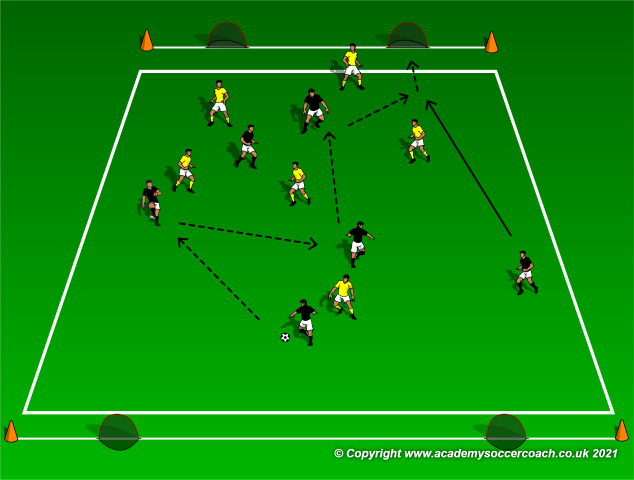
Cool down: Juggle the ball in pairs followed by static stretching exercising and a short recap of the training session.
Duration: 8 minutes.
By Philip Cauchi


